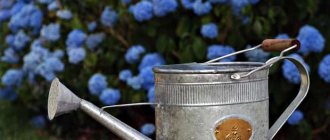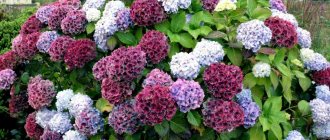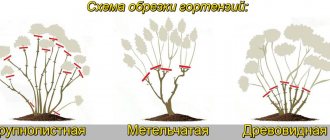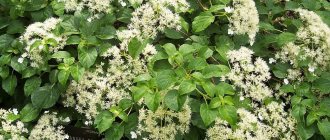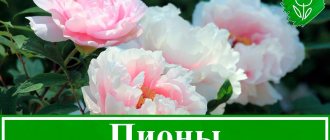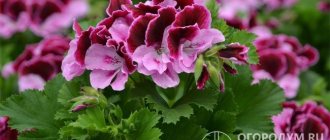- Upon landing
Tree-like, paniculate and large-leaved hydrangeas have long settled in garden plots, city streets, and public gardens. The ornamental shrub is valued for its lush, long flowering, which is guaranteed if proper agricultural practices are followed. Regular feeding plays an important role. We will tell you in detail how to feed hydrangea in the article.
In the botanical classification, the genus Hydrangea (Hydrangea L.) of the Hydrangeaceae family includes about 80 species
Rules for fertilizing hydrangea in the spring
When fertilizing hydrangea, the same rules apply as when fertilizing other garden plants.
- The first feeding after the snow melts is given when the temperature reaches above zero. Only when the soil warms up to +4 +6 degrees are the roots able to absorb nutrients from the environment.
- Watering the plant with a nutrient solution at the root is carried out only on moist soil (the bush is watered abundantly the day before feeding with ordinary water). Roots saturated with moisture will better absorb nutrition and will not get burned.
- The application of solid fractions of fertilizers to the soil surface should be accompanied by shallow loosening, 4-5 cm, and subsequent watering with clean water.
- The solution for foliar feeding (spraying on the leaf) is prepared 2 times weaker than the liquid for watering hydrangeas at the root.
- Bushes should be sprayed in cloudy weather or in the evening, so as not to cause burns on the foliage due to droplets of moisture.
- Nutrient solutions for fertilizing plants should be prepared by accurately measuring the doses of fertilizer. With a high concentration of the active substance, there is a high risk of burning the roots or foliage of the plant.
The specificity of hydrangea cultivation is that it prefers acidic soils for growth. Fertilizers that reduce acidity are not used for it: ash, manure.
The main reasons why hydrangea does not bloom
Sometimes hydrangeas don't bloom because they don't have enough nutrients. There are a number of reasons. Some of them are worth taking into account, since, for example, if the root system of a flower rots or weakens, the plant does not bloom and cannot be fertilized. Remember that not everything depends on the quantity and quality of fertilizing. Although they often become the reason for the lack of budding. Let's figure it out why this happens.
If in the spring the plant begins to quickly gain green mass, and the flower buds do not turn into buds, then the hydrangea has overwintered in unsuitable conditions. The plant does not tolerate temperature drops to 0° and below. Under such conditions, flower buds freeze and may die. Therefore, in the fall, after the last fertilizing of the season has been applied and the perennial has faded, it is covered with insulating materials. In colder regions, such as the Urals, more drastic measures are required. They try to hide low hydrangeas from the cold at home. Tall ones are grown in greenhouses and greenhouses.
The reason for the lack of flowering of hydrangeas may be improper pruning. This disease occurs more often on newly purchased specimens. Pruning is carried out in the spring, clearing the plant of old and wilted stems. Under no circumstances should you cut off last year's strong shoots. Hydrangea flowers form on them. If you do this, you can see the perennial blooming closer to autumn or the next season.
The root system of hydrangeas is very powerful. Its development affects the budding of the plant. If it is weakened or develops in clay soil, then the plant may not bloom, stocking up on strength to overcome unsuitable conditions. Also, budding can be affected by the external environment. For example, hydrangeas do not bloom in extreme heat and in insufficient soil moisture. You should not be overzealous with watering, since the plant also does not tolerate waterlogged soils.
Feeding should be timely and in optimal quantities. They can also greatly affect the development of hydrangea buds. If you apply nitrogen fertilizers in the spring, this will significantly delay the appearance of flowers on the bush. In summer, such fertilizing enlarges the inflorescences, but this has a bad effect on decorativeness, since the stems lie down under the weight of the flowers.
When to apply fertilizers, timing
In spring, hydrangea wakes up when the snow melts - in April. This is a favorable moment to apply the first fertilizing. It is aimed at supporting the active growth of bush shoots and contains the most nitrogen.
2 weeks after the first feeding, the hydrangea is watered with wood tissue-strengthening compounds. If necessary, acidify the soil.
The next spring feeding is aimed at accelerating the growth of young shoots of the plant. It is held in late May - early June.
The approximate scheme for fertilizing all types of hydrangeas looks like this:
- April 10-18 – application of nitrogen fertilizers to accelerate the growth of foliage and shoots;
- throughout May, hydrangea is sprayed with preparations containing manganese to strengthen and flexibility the shoots;
- at the end of May - beginning of June, they give complex feeding, containing all the basic elements, to improve growth and increase the number of young shoots.
How to feed hydrangea in spring for active growth
Fertilizers used for hydrangea are divided into three groups:
- organic (manure, ash, compost, vermicompost);
- mineral (artificial concentrates of various substances);
- folk remedies (infusions, herbal decoctions).
Each type of fertilizer is good in its own way and has pros and cons. You should not give preference to only one type of fertilizer; they are all effective in combination.
For rapid growth of vegetative mass, hydrangeas require nitrogen in the spring. Its maximum amount is contained in manure and bird droppings. But these compounds reduce the acidity of the soil, which is bad for hydrangea. Therefore, these types of fertilizers are not used as top dressing, giving preference to mineral fertilizers and other types of organic matter.
Mineral fertilizers
The mineral fertilizer containing the maximum amount of nitrogen is urea, another name is urea. It contains 46% nitrogen. Urea dosage for feeding hydrangea: 25 g, which is equal to 1 level tablespoon per 10 liters or 1 square meter. m of soil area.
In second place in terms of N content is ammonium nitrate, containing 33% of this substance. Fertilizers take 30 g per 10 liters of water.
Ammonium sulfate not only contains 21% nitrogen, but also has an acidifying effect on the soil, which is what hydrangeas like. It is applied in the form of a solution by watering at the root or by scattering the powder directly on the ground, then loosening and watering. Dosage 35-40 g per 1 square. m.
The chemical industry also produces ready-made complex mineral compositions for feeding hydrangeas for gardeners. They already contain the basic substances needed by the plant in an easily digestible form and the required dosage.
The most popular brands of hydrangea fertilizers among gardeners are:
- Buoy fertilizers (containing nitrogen, phosphorus, potassium and microelements) ensure rapid growth and gorgeous flowering;
- Biomaster offers complex organic-mineral fertilizer (NPK and humates);
- Forte - to increase the formation of inflorescences;
- Fertika - a complex composition for fertilizing plants in late May - early June;
- Agricola promises to enhance the color of flower petals and increase the size of inflorescences.
Along with regular fertilizers, gardeners can purchase special long-acting formulations. Granules or sticks consisting of nutrients are immersed in the soil in the area of the plant's root system. Gradually, under the influence of moisture, the granules dissolve, feeding the hydrangea throughout the season. Such compositions are applied once, in the spring.
Organic fertilizers
Humus or mature compost can be used as the first nitrogen fertilizer for hydrangeas. It is prepared from tops, weeds, vegetable peelings, placing the raw materials in a dense pile and adding the Baikal preparation to speed up the rotting process. After 2-3 years, the plant material turns into a homogeneous crumbly mass.
Humus for feeding hydrangea requires 5-10 kg per bush, depending on the size of the plant. Fertilizer is scattered over the surface of the earth, loosening the soil shallowly, within a radius of 20-30 cm from the hydrangea trunk. To increase the acidity of the soil, peat is added to the humus, up to 100% of the volume of humus.
Biohumus (vermicompost), a waste product of dung worms, is used in the same way. Vermikopost contains humic acids, potassium, phosphorus and other microelements that nourish the plant, strengthen its immunity, and heal the soil.
The liquid form of this fertilizer is an extract and is more quickly absorbed by hydrangea roots. For feeding, 1 part of the fertilizer is dissolved in 8-10 parts of cold water and kept for 24 hours in a warm place. The finished solution is poured under the bush, 8-15 liters each, depending on the size and age of the plant.
Some gardeners use mullein solution for the first feeding of hydrangea, then watering the soil with a solution of citric acid (10 g per 10 l) or vinegar (half a glass per bucket of water) to create the desired acidity.
Mullein is diluted with water in a ratio of 1 to 10 and poured under the root, in an amount of 5-10 liters per plant.
Favorite organic hydrangea fertilizers - video
Folk remedies
“Bread fertilizer” can be used as a nutrient solution for hydrangea. To make it, pour about 1 kg of crackers or stale bread into an 8-10 liter container and fill the product with warm water. The mass ferments in a warm place for about 3 days, then the hydrangea is watered with the liquid. Fertilizer helps increase the content of beneficial microorganisms in the soil.
“Yeast infusion” has similar properties . For 10 liters of warm water take 1.5 tbsp. spoons of dry baker's yeast and 100 g of sugar. The solution is prepared for about a day in a warm place. Before use, it is diluted twice with clean water and poured under the root of the bush.
It is useful for hydrangea to water at the root with a solution based on whey or yogurt. 1 cup of the product is poured into a bucket with 5 liters of water and poured under the bush. Fertilizer acidifies and heals the soil. Spraying hydrangea with the same solution during the budding phase promotes lush flowering of the plant.
In May, when active growth of young hydrangea shoots is observed, the plant is sprayed with a solution of potassium permanganate. The drug improves the elasticity of wood tissue. The solution for treating hydrangea is prepared in pink color.
How to feed hydrangea in spring for lush flowering in the garden
At the very beginning of summer, hydrangea needs not only nitrogen, but also phosphorus and potassium. Complex mineral fertilizers are suitable for this type of hydrangea, in dosage according to the instructions.
You can use a yeast infusion or an infusion of green herbs, which is prepared as follows: a barrel is filled in half with chopped juicy weeds from the garden (dandelion, wheatgrass without roots, nettles, gooseberry, loach) and filled with water. The mixture should ferment at a temperature of +22 degrees (if the weather is cool, the barrel is placed in a greenhouse) for about a week. The mass is stirred periodically. To reduce the strong stench from fermented grass, pour 1 glass of Baikal solution into the barrel. The finished infusion is diluted with clean water in the ratio: 1 part fertilizer to 10 parts water, and the bush is watered.
To increase the acidity of the soil, which may decrease due to the use of organic fertilizers, hydrangea can be treated with Ferrovit. 1.5 g of powder is dissolved in 1 liter of water and sprayed on the foliage of the bush:
- to prevent the appearance of chlorosis 2 times per summer;
- for the treatment of a disease - every week.
How to fix a problem with a houseplant?
Garden perennials in warm regions differ from indoor perennials in their easier and faster development. Hydrangea becomes picky at home too. Here, not only the temperature of the room air and periodic feeding are important for her, but also the lighting and even the location in the house.
Most often, the cause of wilting and death of a plant in protected soil is the unsuitable composition of the soil. The mixture can change its alkaline and acid levels when watered with tap water. Under no circumstances should this be done, especially if you live in a big city. For indoor plants, choose acidic soils; loam is ideal. In order for the hydrangea to acquire a blue tint, it is watered with melt water with the addition of acetic or citric acid. Some gardeners recommend choosing soil for home hydrangea with a high peat content before solving the problem.
Annual replanting to a new location with renewal of the nutrient soil is an important necessity. As for external conditions, the plant does not tolerate darkening and dry air. Lack of watering is detrimental to it. In order for hydrangea to bloom all summer at home, it is necessary to periodically spray it with melted warm moisture. To avoid getting on the inflorescences, you can wipe the leaves with a damp, lint-free cloth.
The reason why hydrangea does not bloom indoors may be the age of the plant. We recommend updating it at least once every 4-5 years. At this age, the perennial can begin to grow and spends less energy on budding. Therefore, experienced gardeners, using vegetative propagation methods, renew the shrub. The same goes for garden perennials.
How to fertilize paniculate hydrangea in spring
The very first spring fertilizing of the paniculate variety of hydrangea is no different from fertilizing other types of plants. The shrub is fed with nitrogen fertilizers, which stimulate the regrowth of greenery. Use:
- an aqueous solution of cow, horse or goat manure;
- a solution of urea (30 g per 10 liters of water) and potassium sulfate (20 g per bucket of water);
- prolonged complex mineral fertilizer, granules are embedded in the soil.
When watering with nutrient solutions, each bush consumes from 2 to 6 liters of liquid, depending on the size of the plant.
The second feeding is given to the plant at the beginning of summer, when the hydrangea is preparing to lay buds. During this phase, the plant needs all the basic elements: potassium, phosphorus and nitrogen. Apply a complete complex fertilizer for hydrangeas or water the bush with herbal or grain fertilizer, and after a couple of days add a solution of superphosphate and potassium sulfate, 40 g and 30 g per 10 liters of water, respectively.
Recommendations
Advice from experienced gardeners:
- If the leaves and flowers on the hydrangea become small and pale, it means it needs to be fed.
- When a plant begins to quickly wither due to lack of nutrients, foliar mineral fertilizing is used.
- Increasing the one-time dosage of any fertilizer is dangerous, as it can harm the roots.
- In the spring, before flowering, hydrangea mainly needs only nitrogen.
- You should not overfeed the crop, otherwise it will “fatten” - increase green mass, but bloom weakly.
- Mineral fertilizers are recommended to be used alternately with organic and folk fertilizers.
- Fertilizers are always applied after or during heavy watering.
- It is better to fertilize in the evening or in the morning.
- It is advisable to mulch the tree trunk circle with pine needles, peat or organic matter.
- Compliance with the instructions is mandatory when using any fertilizer for hydrangea.
In early spring, it is recommended to use a urea solution to saturate the soil with nitrogen.
How to feed hydrangea to change color
Large-leaved hydrangea has an attractive feature from a decorative point of view - the ability to change the color of flower petals, depending on the acidity of the soil. A gardener, by adding certain compounds to the soil, can achieve the appearance of white, pink or blue inflorescences on the bush.
The color of the petals is determined by special substances found in the cell sap of the plant, these are anthocyanates. Depending on the acidity of the soil, these substances change color:
- if hydrangea grows in soil with a neutral reaction, the flower petals will be white;
- an acidic environment will give flowers blue or blue shades;
- In alkaline soil, hydrangea blooms with pink flowers.
In addition to the acidity of the soil, aluminum affects the brightness of the color, enhancing the brightness of the blue color.
To get hydrangea with blue inflorescences on the site, it is necessary to increase the acidity of the soil to a level of 5.5 units and below from April. For this:
- the soil around the plants is mulched with pine needles or acidic peat;
- water the hydrangea with an aqueous solution of ammonium chloride;
- give a solution of aluminum sulfate 15 g per 1 liter of water;
- add ammonium nitrate or urea solution;
- water the plant with a solution of citric acid - 2 tbsp. spoons of powder per bucket of water, spending 1 bucket per bush.
It is necessary to add acidifying solutions to the soil before the end of hydrangea flowering.
Superphosphate and manure solution cannot be used for feeding.
Garden and flower shops sell special fertilizers containing aluminum alum and other elements that increase the acidity of the soil.
Important! To accurately determine the pH level of the soil, you can purchase litmus paper at a garden store.
To obtain blooms in pink-red tones, the acidity of the soil is reduced. To do this, water the hydrangea with an infusion of manure and add a small amount of lime or wood ash. The pH level is checked using litmus paper, bringing it to 6.5-7 units. It is not recommended to exceed this level, as there is a high risk of hydrangea contracting chlorosis.
Diseases and pests
Among the pests, the most dangerous are aphids, mites and stem nematodes. They affect the vegetative parts of the plant, reduce the rate of development and can lead to the death of the bush. If signs of disease are detected (the appearance of characteristic spots, colonies of insects and wilting of leaves), the planting should be treated with an insecticide or use traditional methods - spraying with a soap solution, dusting with wood ash.
Infection with diseases is much more common. As a rule, diseases develop when hydrangea is grown in poor soil and care rules are not followed. The most common diseases of this crop:
- Chlorosis . The leaves become discolored, brown spots appear on the leaf blades and stem. The plant slowly withers and may die;
- Gray rot . Brown spots appear on the shoots, which are covered with a gray coating. The disease responds well to treatment with Bordeaux mixture, most often the flower can be saved;
- Powdery mildew . The leaves begin to turn yellow and curl, and many yellow spots appear on them. As a rule, the disease appears when planting in conditions of high humidity.
The choice of fungicides against the disease depends on its type and symptoms of infection. When carrying out routine preventative treatment every year, the risk of developing diseases is significantly reduced.
Caring for hydrangea in spring is an important part of maintaining and growing these versatile decorative flowers. To enhance the quality of flowering, maintain health and stimulate growth, it is necessary to promptly prune, loosen and mulch the soil. Starting in spring, regular watering is an obligatory part of care, and it is also necessary to fertilize on time.
Gardening tips
Hydrangea paniculata Vanilla Fraze
Experienced gardeners recommend feeding hydrangeas for the first time after spring pruning.
It is convenient to feed large bushes by pouring a nutrient solution into holes made in the soil along the perimeter of the crown. Holes in the ground are made with a sharp stake to a depth of 15-25 cm, 4-6 pieces for each plant. Fertilizer is poured directly into the holes, sprinkling soil on top of the holes. This method of fertilizing allows the fertilizer to reach the roots more quickly, and the valuable liquid does not spread over the soil.
Hydrangea is a moisture-loving plant that is not only watered 2-3 times a week, but also sprayed in hot weather.
